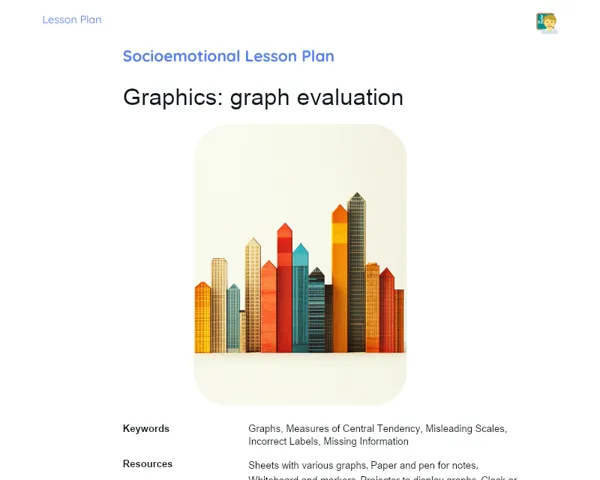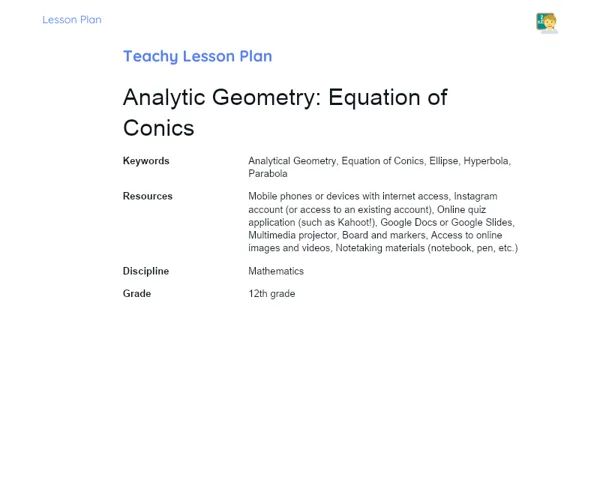Lesson Plan | Lesson Plan Tradisional | Area: Composite Figures
| Keywords | Area, Composite Shapes, Triangles, Rectangles, Decomposition of Figures, Area Calculation, Practical Examples, Problem Solving, Architecture, Engineering, Mathematical Skills, 7th Grade, Primary Education |
| Resources | Whiteboard, Markers, Ruler, Calculators, Sheets of paper, Pencils, Erasers, Projector (optional), Presentation slides (optional) |
Objectives
Duration: (10 - 15 minutes)
The aim of this stage is to get students acquainted with the objectives and skills that will be developed during the lesson. With a clear understanding of what's expected from them, students will be able to focus better on the explanations and follow-up activities. This initial phase is key for steering learning and laying out a clear roadmap for the lesson.
Objectives Utama:
1. Calculate the area of composite shapes made up of triangles and rectangles.
2. Solve problems involving areas of figures, such as the total area of a house.
Introduction
Duration: (10 - 15 minutes)
The purpose of this stage is to engage students and make them aware of the real-life applications of calculating composite areas. By linking the content to real-world scenarios, student interest and motivation to learn the topic grow.
Did you know?
Did you know that architects and engineers use concepts of composite areas when designing houses, buildings, and even parks? They must calculate the areas of the different segments of the construction to estimate the materials needed and the overall costs.
Contextualization
To kick off the lesson on the area of composite shapes, present students with a practical, real-world example. Begin by asking: 'Who here has ever helped measure a room in the house for a new rug or flooring?' Explain that these spaces often aren't straightforward shapes like squares or rectangles but rather a mix of various basic forms. This approach helps students see the relevance of the lesson in their everyday lives.
Concepts
Duration: (40-50 minutes)
This stage aims to deepen students' understanding of how to calculate the area of composite shapes by utilising practical, everyday examples. With detailed explanations and collaborative problem-solving, students will learn to visualize the process of breaking down complex shapes into simple figures and properly apply area formulas. This segment also seeks to develop their problem-solving skills and logical reasoning, which are crucial for a well-rounded grasp of the topic.
Relevant Topics
1. Introduction to the Concept of Composite Shapes: Introduce composite shapes, explaining they are formed by combining two or more simple geometric figures, such as triangles, rectangles, and circles. Highlight the importance of breaking down composite shapes into simpler figures to calculate the total area.
2. Practical Example 1 - Area of a House: Draw a simplified floor plan of a house featuring several rectangular and triangular rooms on the board. Demonstrate how to divide this plan into simple shapes and calculate each area, tallying them at the end to find the total area.
3. Practical Example 2 - Area of a Garden: Use an example of a garden with both rectangular and triangular sections. Walk students through how to calculate each area's size step-by-step, then combine these areas for the total garden area.
4. Tips and Strategies: Offer some helpful tips for breaking down composite shapes, such as looking for lines of symmetry, recognising overlapping shapes, and using basic area formulas (like that for triangles and rectangles).
5. Problem Solving: Present practical problems for students to tackle, like calculating the area of an irregular plot or a uniquely shaped pool. Lead the class in solving these problems, emphasising each step of breaking down and calculating areas.
To Reinforce Learning
1. Draw a composite shape using a rectangle and a triangle. Calculate the total area of this figure.
2. A living room is shaped like a rectangle with an isosceles triangle on top. The rectangle measures 5m by 3m, and the triangle has a base of 5m and a height of 2m. What is the total area of the room?
3. A piece of land has two adjacent rectangles. The first rectangle is 6m by 4m, and the second is 8m by 3m. Calculate the total area of this land.
Feedback
Duration: (20-25 minutes)
This stage's objective is to ensure that students fully grasp the explanations and calculations shared during the lesson. This segment invites open discussion, allowing them to clarify doubts and share their solutions. It also encourages student engagement through questions and reflections that make connections between the content and real-world scenarios or different subjects. By the end of this phase, students should feel more confident using their knowledge of calculating areas of composite shapes in various contexts.
Diskusi Concepts
1. 🔍 Question 1: Draw a composite shape using a rectangle and a triangle. Calculate the total area of this figure.
Explanation: To answer this question, students should begin by sketching the composite shape. Then, they should find the area of the rectangle and the area of the triangle separately. The area of the rectangle is calculated as A = base × height. For the triangle, it’s A = (base × height) / 2. Finally, combine the two areas to determine the overall area of the composite shape.
Example: Consider a rectangle with a base of 4m and a height of 3m, along with a triangle that has a base of 4m and a height of 2m. The area of the rectangle is 4m × 3m = 12m², and the area of the triangle is (4m × 2m) / 2 = 4m². So, the total area is 12m² + 4m² = 16m².
2. 🔍 Question 2: A living room takes the shape of a rectangle with an isosceles triangle on top. The rectangle measures 5m by 3m, and the triangle has a base of 5m and a height of 2m. Calculate the total area of the room.
Explanation: First, calculate the area of the rectangle using the formula A = base × height. Then, find the area of the isosceles triangle with the formula A = (base × height) / 2. Finally, add up these two areas to get the room's total area.
Example: For the rectangle, the area is 5m × 3m = 15m². The area of the triangle is (5m × 2m) / 2 = 5m². So, the room's total area is 15m² + 5m² = 20m².
3. 🔍 Question 3: A plot of land features two adjoining rectangles. The first rectangle measures 6m by 4m, while the second is 8m by 3m. Calculate the total area of the land.
Explanation: Find the area of each rectangle separately using the formula A = base × height, and then sum the two areas to get the total land area.
Example: The first rectangle's area is 6m × 4m = 24m², and the second's area is 8m × 3m = 24m². Thus, the total land area is 24m² + 24m² = 48m².
Engaging Students
1. 📋 Question 1: What other geometric shapes could be combined to create even more complex figures? How would we calculate the area of those?
2. 📋 Question 2: In what ways could we apply the idea of breaking down composite shapes in other subjects, like Science or Geography?
3. 📋 Question 3: Can you think of practical examples at home or in school where calculating composite areas would come in handy?
4. 📋 Reflection: If the composite shape included a circle or a semicircle, how would we go about calculating the total area? (Remember that the formula for the area of a circle is A = πr².)
Conclusion
Duration: (10 - 15 minutes)
This final stage serves to recap and reinforce the key content covered throughout the lesson, ensuring students grasp the concepts and their practical applications. It's a moment to emphasise the topic's importance and motivate students to apply their new knowledge in everyday tasks.
Summary
['Introduction to composite shapes made from simple geometric figures.', 'Demonstration of how to decompose composite shapes into simple figures to find the total area.', 'Practical examples calculating composite areas via floor plans of houses and gardens.', 'Strategies and tips for breaking down composite shapes.', 'Guided problem-solving that involves calculating the areas of composite shapes.']
Connection
The lesson effectively linked theory with practice, using everyday examples such as house and garden floor plans to show how composite area concepts are applied. By breaking down complex shapes into simpler parts and calculating their areas, we highlighted the content’s practical relevance in real-life situations, such as measuring indoor and outdoor spaces.
Theme Relevance
This subject holds significant importance for daily life, as calculating composite areas is vital for various practical tasks. Architects, engineers, and other professionals rely on these principles to design structures and estimate material requirements. Furthermore, understanding how to compute composite areas proves helpful for domestic activities, like measuring spaces for furniture placements or renovations.



